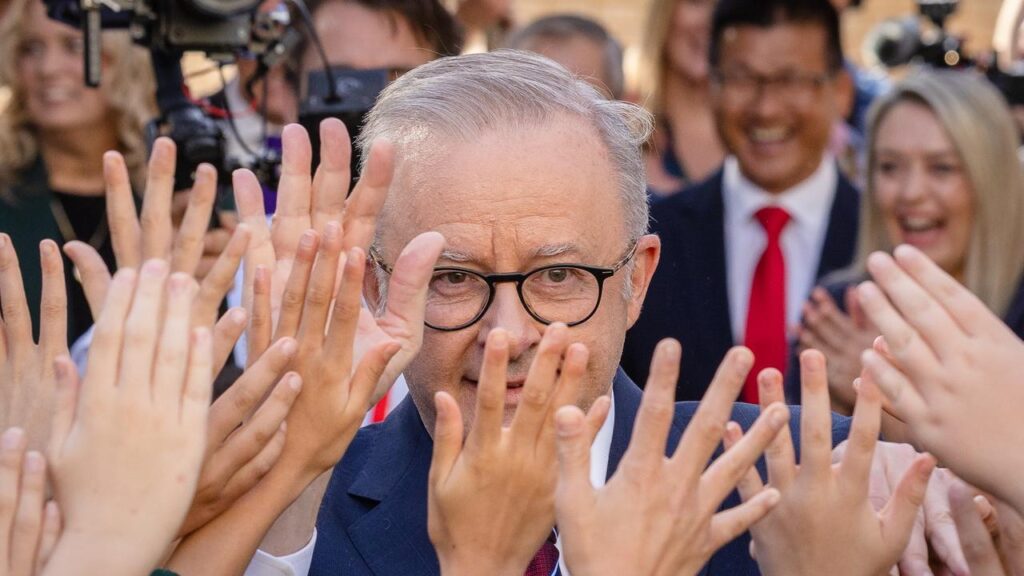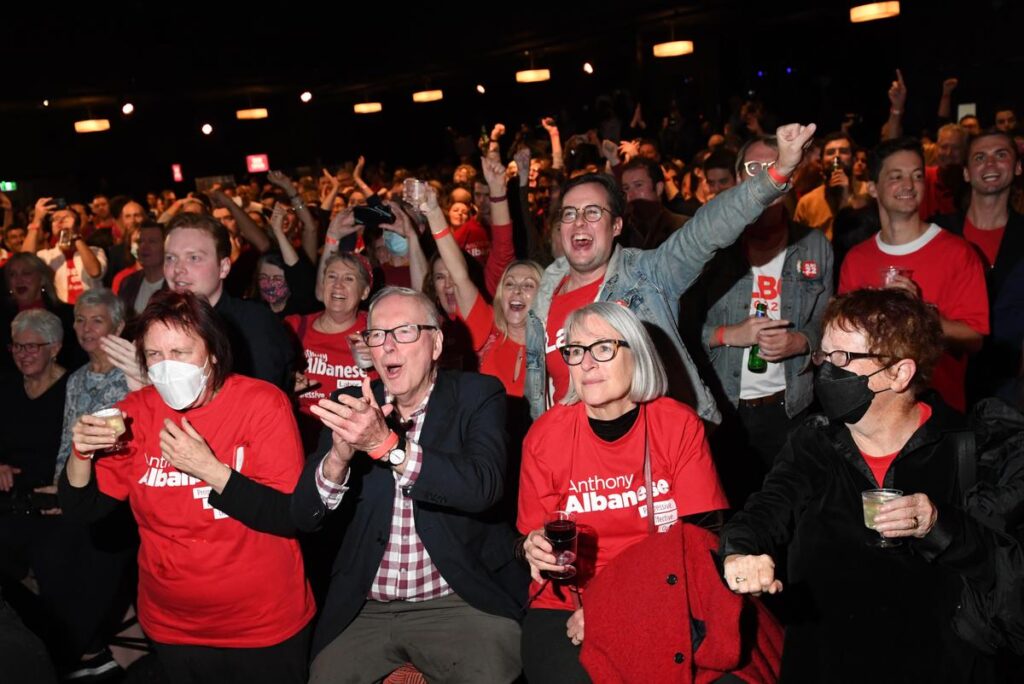It began in Canada, and now the same pattern has emerged in Australian election results: the ruling center-left, struggling with waning public support, made a sudden comeback just before the elections. Although some recognition must be given to their endeavours, most of the change is being associated with President Donald Trump of the U.S.
The BBC called the result of Saturday’s general election in Australia, in which the current Labor Party came out a winner, “The Trump Effect.” Even if CNN talked about Trump’s trade war that affected both American and Australian ratings, and that was the significant factor that influenced the Australian election results.
The Australian election results displayed that at least 87 of the 150 seats in the House of Representatives were occupied by Anthony Albanese’s Labor Party. This is going to be the first time in 20 years when a returning Prime Minister will be in office for the next term.
Opposition leader Peter Dutton of the conservative Liberal Party has already conceded defeat. BBC headlined his downfall as: “He wanted to be Prime Minister, but the Trump effect crushed him.”
The repeated mention of Trump raises the question—what exactly did he do to impact the Australian election results and those in Canada?
In reality, Trump did not directly interfere in the elections. However, when the President got back to the White House in January of this year, his decision to impose new tariffs to “Make America Great Again” changed the political climate of two main U.S. collaborator countries completely.
Prior to that, the Canada’s ruling Liberal Party had been experiencing a severe drop of support which resulted in the Prime Minister Justin Trudeau’s resignation.
But in April’s election, Trudeau’s successor Mark Carney managed to retain power for the Liberals.
A similar scenario played out in Australia. Amid global instability triggered by Trump’s trade war, voters leaned toward stability over change. As a result, Albanese is now set for a second term as Prime Minister.
When the Australian election results became clear on Saturday night, an emotional Albanese addressed a cheering crowd in Sydney and said, “In the face of global uncertainty, Australians have chosen the path of hope and resolve.”
Yet public opinion polls had earlier suggested a different outcome—leading Peter Dutton to hope he might become Prime Minister. However, he also lost his seat in Brisbane’s outskirts, an area he had represented over 20 years.
Obviously surprised by what took place, Dutton frankly confessed his defeat by saying, “Tonight wasn’t our night.”
Following the Australian election results, world leaders sent congratulations to Albanese. U.S. Secretary of State Marco Rubio described Australia as a “valuable ally.” British Prime Minister Keir Starmer stated that the enduring bond between the two nations would only grow stronger.

A Shift to the Left
After Trump imposed a 10% tariff on Australian goods, voters began debating which candidate was better equipped to handle such pressure.
Although Albanese couldn’t reach Trump by phone, he stated they had previously enjoyed warm conversations and that he had no reason to distrust the U.S. President. He affirmed that Canberra would remain a Washington ally despite the tariff threats.
Dutton, on the other hand, started his campaign from a strong position. But analysts argue that policy missteps, resistance to change, and Trump’s destructive approach to global affairs deeply undermined Dutton’s chances.
Conversely, Albanese’s Labor government maintained a firm yet diplomatic tone in response to Trump’s 10% tariff on Australian goods. Trump eventually suspended the tariff decision.
In a press conference, Albanese remarked, “What Trump has done is not the act of a friend.”
Dutton struggled to counter criticism when opponents repeatedly likened him to Trump.
Some of Dutton’s policies were clearly inspired by Trump. His supporter, Senator Jacinta Nampijinpa Price, even echoed Trump’s famous line, saying they wanted to “Make Australia Great Again.”
When asked whether the Trump comparison had damaged Dutton after the Australian election results, Price responded, “If you sling enough mud, some of it will stick.”
A Strong Mandate
As inflation remained unchecked amid global economic instability, Albanese faced public criticism. All the same, he has given a word on tax reliefs, more affordable medicinal products, and the erection of 1.2 million homes to deal with the housing crisis.
Albanese’s leadership is considered to have been a key factor in the improvement of the Australian-Chinese relationship for the last three years which eventually led to more favorable trade deals between Australia and China.
He was first elected in 2023, with the promises to reduce the country’s carbon footprint, and to reach net-zero by 2050. However, his government was later condemned for allowing new coal and gas projects.
On the occasion of his recent success, Mr. Albanese restated his stand on the matter of the climate crisis, saying, “All Australians know that renewable energy is the future of our economy.”
Dutton’s plan of constructing seven nuclear power plants with public funds will also be stopped as a result of the Liberal Party’s loss.
David Ritter, CEO of Greenpeace Australia Pacific, said, “The Australian election results show that Australians have decisively rejected the Trumpist agenda of climate and environmental destruction and the dangerous nuclear energy plans.”

The End of Dutton’s Career
Dutton, who rose from being a police officer to holding critical roles like Minister of Defence, Immigration, and Home Affairs, had long been grooming himself to become Prime Minister.
Post the Liberal Party’s 2022 loss, Dutton took the helm of the party and made himself a highly influential figure on the right-wing.
Dutton, in the 2025 election, repeatedly charged Albanese with the failure of not having protected Australia against Trump’s tariff threats and claimed that he could have handled the case more effectively.
Yet, the polls were starting to unravel their truth—such as the fact that voters really disliked his Trump-style politics, and that was when Dutton made his U-turn putting himself away from the American president.
Nevertheless, in the last week of the campaign, he was back to the Trump-inspired rhetoric by attacking the national broadcaster and the left-wing Guardian newspaper of Australia.
Two years ago, Dutton had the wind at his back by defeating the government’s referendum proposal for the constitutional recognition of Indigenous Australians. However, his recent setback has marked a full stop to his political career.
On the other hand, the victorious Albanese has pledged to unite Australia and face all future challenges together.
Political Parties of Australia
Australia’s political landscape is home to a variety of political parties. They are characterized by different histories, ideologies, and public support. These political parties not only influence but they are also the ones responsible for the policy-making process.
A good example is the Australian Labor Party. This party is the premier center-left party in Australia and it is one of the oldest having been established in 1891. The platform of the party is based on workers’ rights, social justice, and the idea of change, while Anthony Albanese is leading the party in parliament with his key areas of reform concentrating on health, education, and climate.
Conversely, the Liberal Party of Australia is a party with a very different ideology where they always focus on conservative issues, such as the free market, tax cuts, and national security. Since its inception in 1944, the party has always been able to obtain active support from businesses and the upper-middle-class economic group. At present, the party is the opposition in government and is Peter Dutton is the leader.
The Liberal Party is backed by the National Party of Australia, which is a party that stands for the rights of the rural and regional people primarily. This party is essential for the protection of farming communities, the expansion of rural infrastructure, and the resource industry. The Nationals, headed by David Littleproud, are currently also in collaboration with the Liberal Party.
The Greens, known for their progressive environmental policies, are highly esteemed by young city dwellers and those who are environmentally conscious. The party was born in 1992 as a result of the successes of this social movement, and hence it maintains its agenda doubling down on climate change, Indigenous rights, and the redistribution of wealth.
Furthest to the right on the political scale stands Pauline Hanson’s One Nation that is famous for its aggressive and strongly anti-immigration remarks. The organization was established in the 1990s, they have been working to maintain Australian cultural identity and have been limiting immigration.
There are also smaller political parties like the United Australia Party of Clive Palmer and the Jacqui Lambie Network, and some independent candidates that are involved in our political system.
Read More: Why Warren Buffett step down from Berkshire Hathaway
